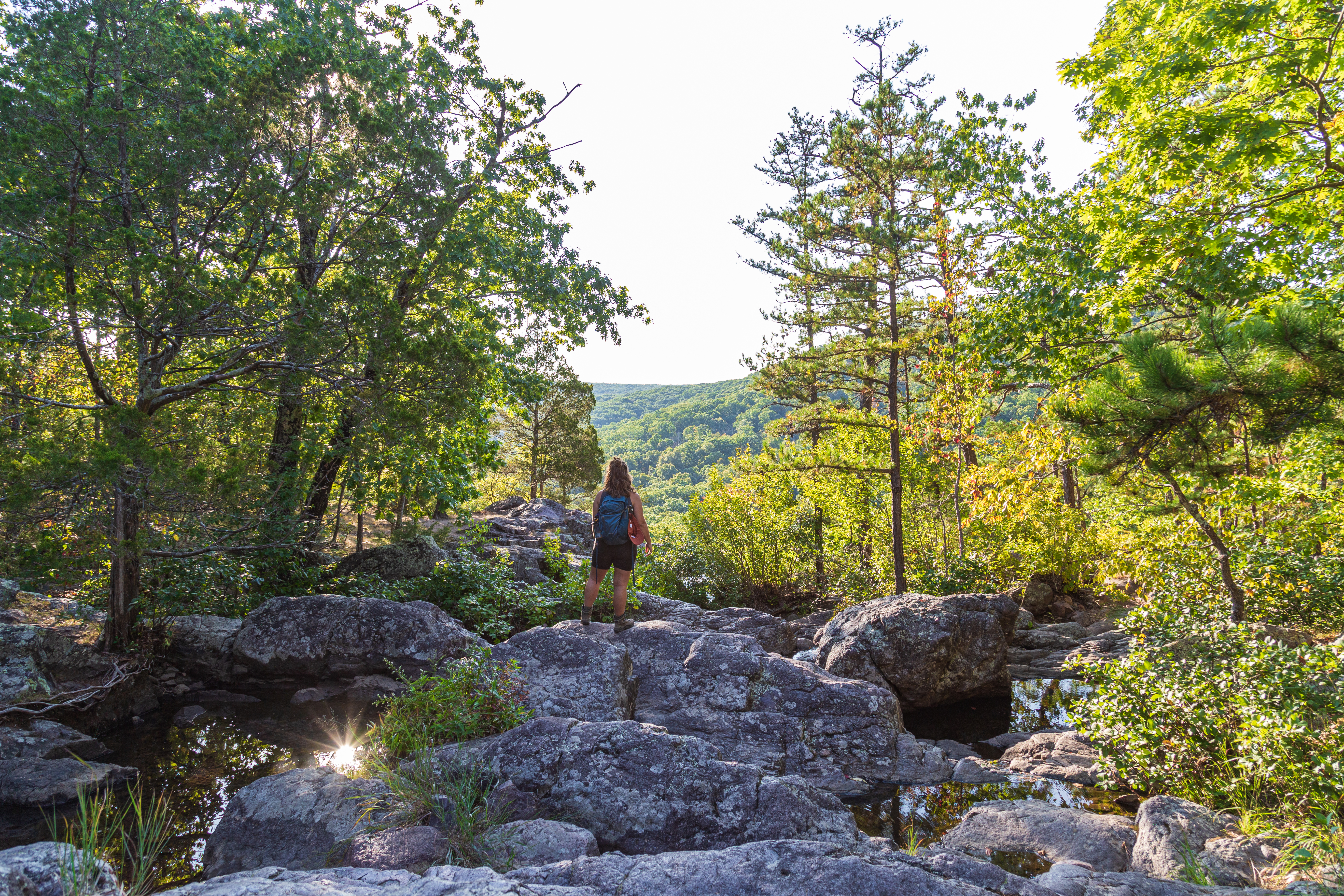A great effort is underway to restore our natural prairies, glades, woodlands, and marshes. Learn how this is being done and where you can see these restored areas. And read about how the owners of Missouri Life are creating natural habitat on their farm.
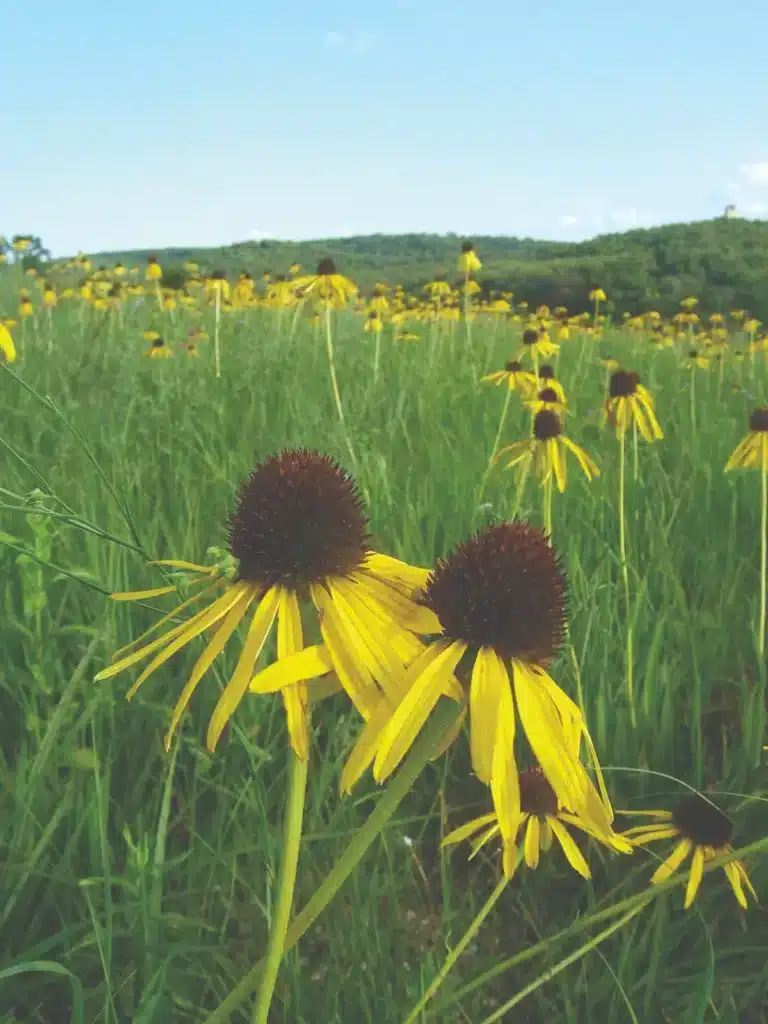
Photo by Allison Vaughn
KEEPING IT REAL
STORY Sandy Selby
Wildflowers add welcome splashes of color. Birds and bees are thrilled. Snails and tarantulas are celebrating a homecoming. The decades-long effort to restore natural habitats in many of Missouri’s state parks is paying off as wildlife and native plants return, and visitors learn how our state looked before settlers began reshaping it. The mission, according to Ken McCarty, director of the Natural Resource Management Program for Missouri State Parks, is to restore Missouri’s outstanding natural landscapes and to help Missourians appreciate the biological diversity of the state.
PRAIRIES
The wide expanses of prairie that once stretched across the state were plowed under in favor of agriculture and infrastructure. The wildfires that swept across those open plains, clearing dead vegetation and enabling sunlight to reach the soil, were curtailed. It’s only because of the dedicated efforts of Missouri State Parks and other agencies and organizations, such as the Missouri Department of Conservation, the Missouri Prairie Foundation, and The Nature Conservancy, that we can still enjoy the sight of natural prairies in Missouri.
According to Ken, prairie restoration requires a lengthy commitment to planting, prescribed burning, and watching and waiting. One of his first projects with Missouri State Parks was to restore the prairies at Long Branch State Park at Macon. After 35 years of careful nurturing of grass and wildflower survivors from early periods of the region’s history, that prairie is maturing. Today, it is representative of the prairies that sustained populations of bison and elk and many of Missouri’s indigenous people.
“In that sea of grass, you’ll find 40 species of grasses, a host of prairie wildflowers, including blazing stars, Indian paintbrush, lead plant, coreopsis, compass plant, and ragged orchid that hardly exist anymore,” Ken says. The prairie is an ideal breeding spot for grassland birds, such as northern harriers, Henslow’s sparrow, dickcissels, loggerhead shrikes, and quail. And pollinators, including more than 100 species of native bees, buzz around the wildflowers that now blanket that landscape.
“Even a small remnant can have 150 to 200 species of wildflowers,” Ken says. “Prairie State Park in Barton County [near Mindenmines] has over 600. The flowers in bloom at any one time change from spring to summer and fall in an ancient, seasonal progression across our native prairies, and it is inter- esting to watch the kinds of bees, moths, butterflies, beetles, spiders, and other small creatures change in kind. It’s gratifying to see all that lives in, among, and because of the prairie.”
Other state park prairie restoration projects are not as far along, but part of the fascination for nature lovers is in discovering the changes that occur in these prairies-in-progress from year to year. What’s blooming this year that wasn’t there before? What birds have returned to nest beneath the shelter of the tall grasses?
“If we can reassemble the flora where prairies once grew, nurture them with fire, and protect them from exotic invasive weeds, there’s an opportunity for them to thrive.” Ken says.
VISIT REMNANT AND RESTORED PRAIRIES IN THESE MISSOURI STATE PARKS
Annie & Abel Van Meter State Park, Miami (early-stage reconstruction)
Arrow Rock State Historic Site, Arrow Rock (early-stage reconstruction)
Battle of Island Mound State Historic Site, Butler (early-stage reconstruction)
Cuivre River State Park, Troy (well-established remnant)
Long Branch State Park, Macon (well-established remnant)
Mark Twain State Park, Florida (well-established remnant)
Prairie State Park, Mindenmines (one of Missouri’s largest native prairie remnants)
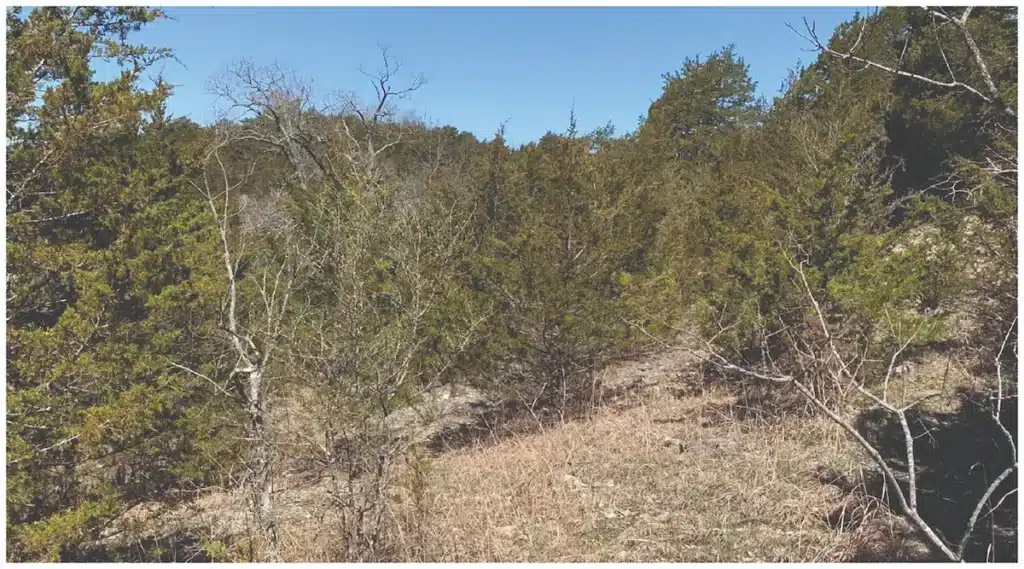
GLADES
Glades are somewhat similar to prairies as they mainly consist of grassy areas, but rather than occurring on flat plains, they are found among the hills. In Missouri, they were especially prevalent in the southern part of the state. The famous bald knobs of the Branson area are a prime example. According to Chris Crabtree, a natural resource ecologist for Missouri State Parks, “The local hills had grassy glades along many of their slopes, and from a distance they appeared barren or bald. That’s where the term bald knob came from. In most places where glades occur, they are found on south and west exposures. In the White River Hills Region, they can also be found on northern and eastern exposures.”
Chris is heading up the glade restoration at Shepherd of the Hills State Park, a new park currently under development near Branson and not yet open to the public. “Since probably the late 1960s, early 1970s, some of these glades started getting overrun with cedar trees. I’ve been working the past four seasons on glade restoration throughout that park.”
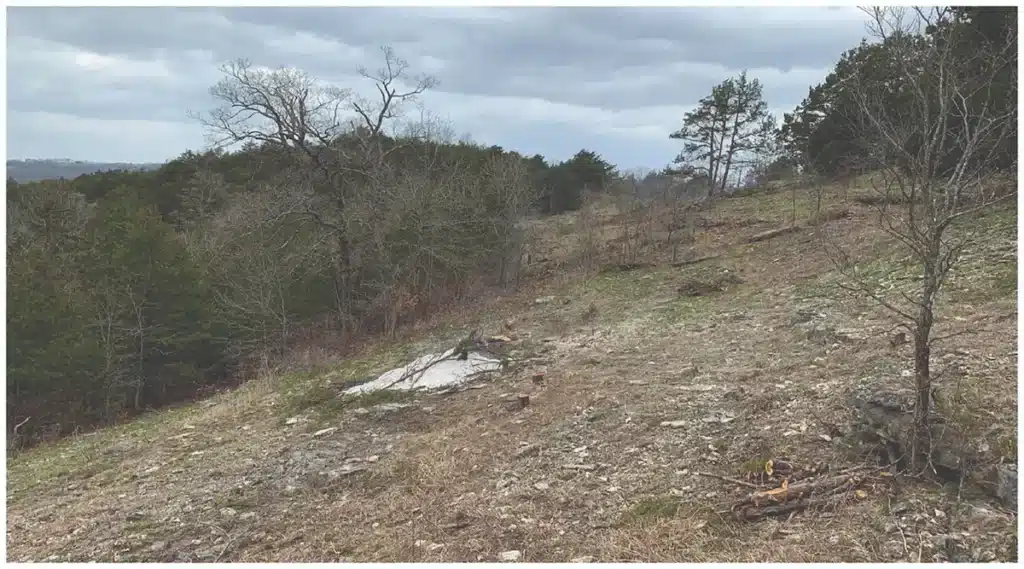
Photo by Allison Vaughn
Fortunately, the cedar encroachment is reversible and the glades are salvageable. “They haven’t been covered in cedar so long that all remnants of the glades have been lost” Chris says.
The glade decline can be traced to grazing by cattle, horses, and goats, and in some cases, the use of herbicide to eliminate shrubs and wildflowers and make room for grass for grazing. The disturbed soil that resulted from grazing was ideal ground for the opportunistic cedars. They don’t require particularly good soil or a lot of soil to grow, and soon they began their takeover.
“At Shepherd of the Hills State Park, herbicide application occurred on only a few of the glades. It was at these locations that we chose to transfer seed from other glades within the park,” Chris says.
With proper glade restoration, the grassy, flower-filled, and rocky landscape is returning and so are some of the species that thrive in that environment, such as scorpions, tarantulas, and roadrunners, along with yellow echinacea, small palafox, and Trelease’s larkspur.
Unlike with prairie projects, the team often sees quick results with glade recovery work. “For some glades, simply removing the cedars is all that is necessary,” Chris says. “Immediate gratification comes from that removal and opening-up of the landscape.”
VISIT RESTORED GLADES IN THESE MISSOURI STATE PARKS
Graham Cave State Park, Danville
Ha Ha Tonka State Park, Camdenton
Johnson’s Shut-Ins State Park, Middle Brook
Lake of the Ozarks State Park, Kaiser
Meramec State Park, Sullivan
Onondaga Cave State Park, Leasburg
Roaring River State Park, Cassville
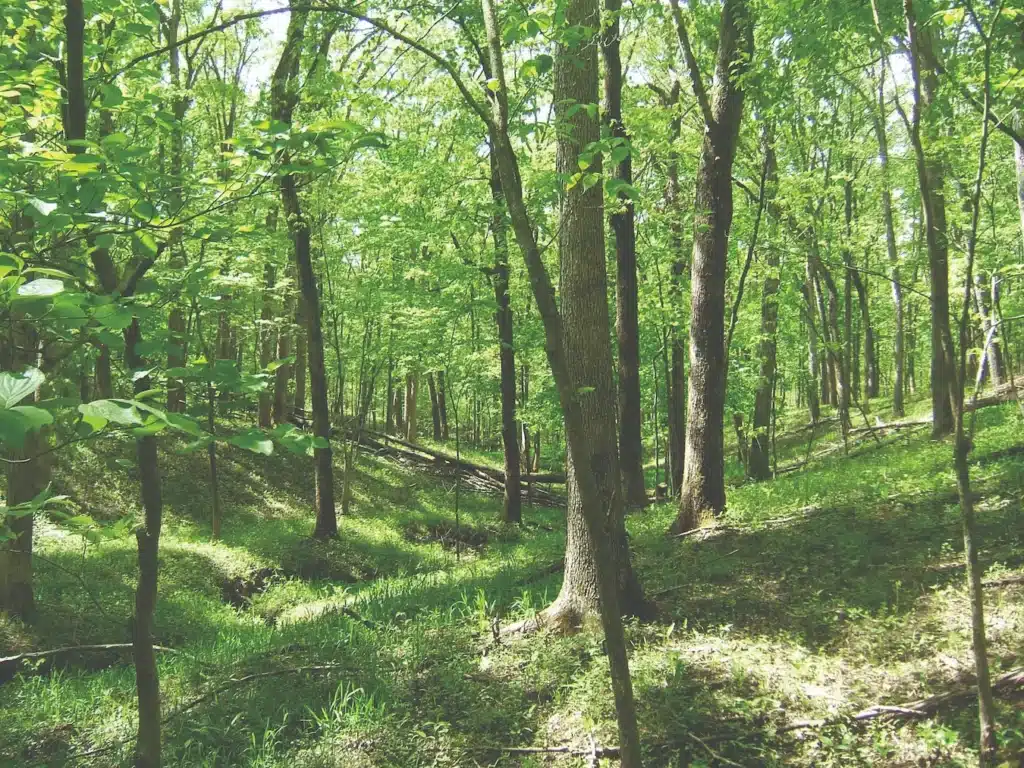
Photo by Allison Vaughn
WOODLANDS
Missouri is blessed with forests, but Ken points out that today’s woodlands don’t look like those that early European visitors to this area would have seen. “They’ve changed in character a lot,” he says. “There have been different ways we’ve used the land with timber production, open grazing, and long fire-free intervals. What they are today is much different in substantial ways than what they were in their native, natural forms.”
Ken says the forests of late prehistoric and early recorded historic times in this region were more open beneath old-growth canopies of fire-tolerant oaks, hickories, and in southern Missouri, shortleaf pines. “The forest floors were covered in rich layers of herbaceous ground flora. Those grasses, sedges, shrubs, vines, and wildflowers require light to persist, something that the layers of understory trees block in most contemporary forests. But restore the light beneath the tree canopies, return the occasional surface fire, and several hundred species of native plants can thrive. Much like the prairies, there develops a seasonal progression of plant presence and blooms that support a complex web of life.”
There are two approaches to woodlands restoration in Missouri State Parks.
“Woodlands are either reinitiated through prescribed burning, like the fires that historically maintained Missouri’s oak and oak-pine woodlands,” Ken says, “or we thin overstocked woodlands first, then begin the prescribed burns. The plants are generally there and just need the light and recurring fires to redevelop on their own. With enough time, they can become truly magnificent.”
The result is a restored forest that looks as it would have 200 to 500 years ago, when the space between trees was open enough to ride a horse through and when colorful wildflowers and dappled sunlight decorated the forest floor.
VISIT RESTORED WOODLANDS IN THESE MISSOURI STATE PARKS
Ha Ha Tonka State Park, Camdenton
Lake of the Ozarks State Park, Kaiser
Meramec State Park, Sullivan
St. Joe State Park, Park Hills
Taum Sauk Mountain State Park, Ironton
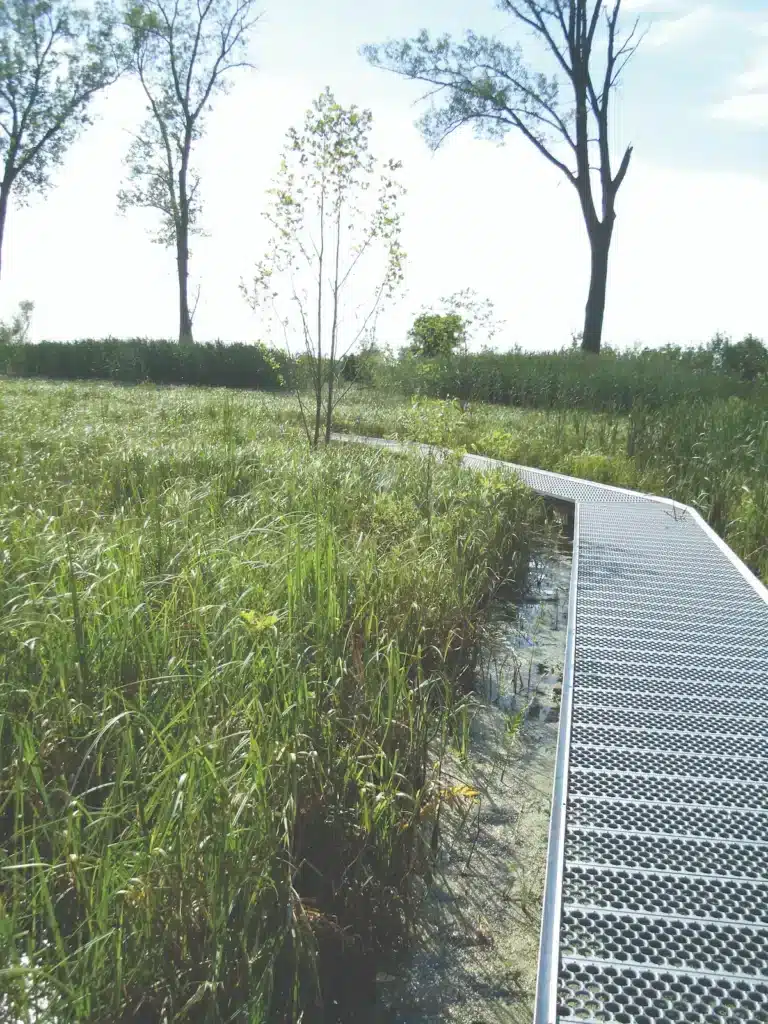
Photo Courtesy of Missouri Department of Natural Resources
MARSHES
Missouri’s low-lying wetlands are a favorite stop for migratory birds and butterflies but, like prairies and glades, marshes have given way to human endeavors.
High-quality marshes, where native plants and historic character remain intact, are rare. There are a few in the state, like those at the Mingo National Wildlife Refuge at Puxico, and Columbia’s Eagle Bluffs Conservation Area. And there are marshes here and there in the state parks system, including a large one at Big Lake State Park near Craig, but only one offers a glimpse of a presettlement landscape. It’s at Annie and Abel Van Meter State Park near Miami. “It’s a very nice marsh system,” Ken says, “but in 1986 it had been so long drained and dried that elms, cottonwoods, and box elder trees had almost completely displaced the original marsh plants, pushing them to the lowest patches where water still pooled in the wet seasons.”
The restoration effort involved adding earthen structures for water retention and cutting invading trees. With the help of prescribed burning, remnants of the marsh began to flourish. “There is character there,” Ken says. “Waving bullrushes, birds, butterflies, and rare marsh species such as star duckweed, tufted loosestrife, and a particular species of pond snail that survives from Missouri’s glacial times.”
A raised walkway allows visitors to meander through the marsh without getting their feet wet, and interpretive signs offer information about the flora and fauna of the landscape. “The fun part has been restoring nature,” Ken says. “So much is residual. It’s there in pieces. We’re putting it back in a living, thriving landscape.”
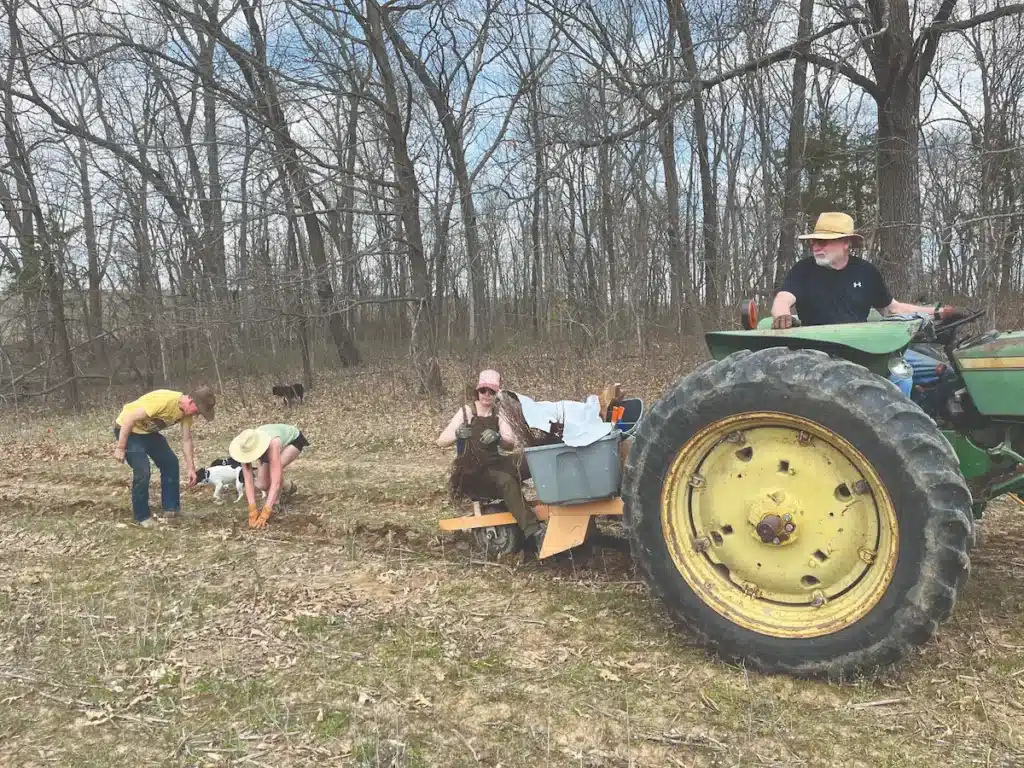
CREATING A HABITAT IN HOWARD COUNTY
STORY Greg Wood, Publisher, Missouri Life
A couple of years ago, Danita and I decided to put 132 acres of our Boonslick Trail Farm cropland into the Conservation Reserve Program (CRP). We found out that there were several different CRP programs, and the one that we felt would be the best fit for our farm was a quail habitat program called SAFE (State Acres for Wildlife Enhancement). According to the Missouri Department of Conservation, our state’s quail population has declined by 80 percent in the last 50 to 60 years. We liked the thought of reestablishing one of Missouri’s favorite bird species and seeing all those prairie flowers and warm season grasses, so we decided to enroll.
The program required us to plant over 50 different species of native plants and wildflowers, as well as 5,500 shrubs. That sounded like a lot of work!
For the best stands, planting all the seeds by drill was preferred. Fortunately, there are several companies in Missouri that not only raise and sell their own native plant seed, but they can also do the planting. The one I chose to work with is Pure Air Natives out of St. Louis and Wentzville. They have been doing this for many years, and they got our seeding done during the perfect time of the year, which is February, just before the last snowfall. The snow helps take the seeds down into the ground where there is a better chance for survival.
Sure enough, this summer our CRP ground turned into a flower garden—well, almost. A lot of weeds also came up, but that is par for the course. I will use controlled burns, mowing, and some tillage to keep weeds suppressed.
Then there was the matter of putting 5,500 shrub seedlings in the ground. This seemed a bit daunting, and I wasn’t sure how Danita and I could possibly plant that many by hand. At first, I thought I could hire it done like the seeding, but I could not find anyone who could do it. So, I contacted the Missouri Department of Conservation office in Columbia, and they allowed me to borrow one of their tree planters.
Okay, great! Now what? We still needed help, so we recruited our kids, and they all came to help—our son Evan, who is living in Chicago; our daughter Callina and son-in-law Andrew, who live in Minnesota; and our daughter Marissa, who was living in Columbia at the time. Even the grandkids helped cover up the bare roots that the tree planter often missed. I must give Andrew a special shout-out for helping to manage the entire effort of planting almost 6,000 seedlings into 32 quail habitat areas. It would not have been as efficient or successful without his help. He’s a farmer and knows equipment and how to get things done.
We look forward to seeing the transformation in the coming months and years, and hope that not only quail but other birds and animals will make themselves at home on our farm.
Visit Missouri Department of Conservation’s website at MDC.mo.gov. Search for “quail” for guidance on habitat creation.
Purchase the Missouri Life “Green Issue” to read more about ways Missouri is going green here.
Article originally published in the January/February 2024 issue of Missouri Life.
Related Posts
Missouri State Library Established
On January 22, 1829, the Missouri State Library was established in Jefferson City.

